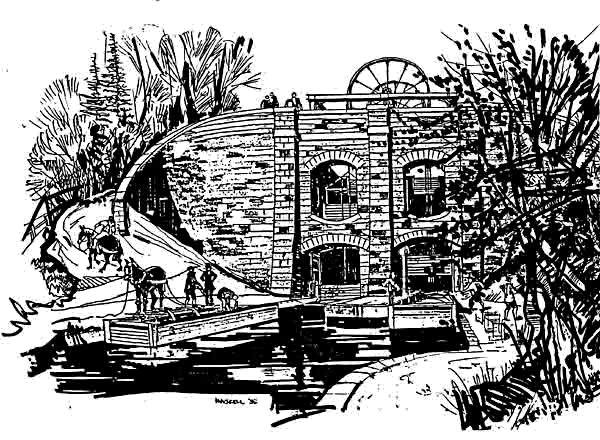GRAND WESTERN CANAL AT NYNEHEAD
James Brindley first surveyed the Grand Western Canal in the 1760's as part of a grand scheme to link the Bristol and English channels in order to save shipping from the dangers of navigating around Land's End. An Act of Parliament was eventually obtained in 1796, but work did not commence until 1808 when there was a revival of interest and much financial activity. John Ronnie was appointed engineer in 1810 and construction began at the summit level near Holcombe Rogus, working towards Tiverton; the idea being to take advantage of an expected trade in limestone. The eleven-mile section was opened in 1814 but engineering difficulties had exhausted the Company's funds and the plan to link with Taunton was temporally shelved.
In 1827 the Bridgwater and Taunton Canal was opened giving fresh impetus for extension of the Canal to Taunton.

A conjectural view of a Grand Western Canal Lift by Tony Haskell
James Green's proposal to complete the 13 mile extension from Lowdwells to Taunton with a tub-boat canal (see below) was accepted and work begun in 1831. It incorporated an inclined plane and seven vertical boat lifts to cope with the 270 ft change in level. There were problems with the inclined plane at Wellisford, which delayed completion, and Green ceased to be Engineer in 1836. Eventually a steam engine was fitted to the plane and the Canal finally opened to through traffic in 1838.
Newer forms of transport were to be the Canal's undoing. The Bristol and Exeter Railway reached Exeter in 1844 with a branch to Tiverton in 1848. Canal revenue fell dramatically.
In 1854 the Canal was leased to the railway that then bought it out in 1865. The Somerset section was closed shortly afterwards and the land and machinery sold by 1867. The carriage of limestone and roadstone continued on the Devon section until 1925, thereafter the Canal remained derelict until 1971 when Devon County Council took over the ownership, designated it as a Linear Country Park and commenced restoration.
